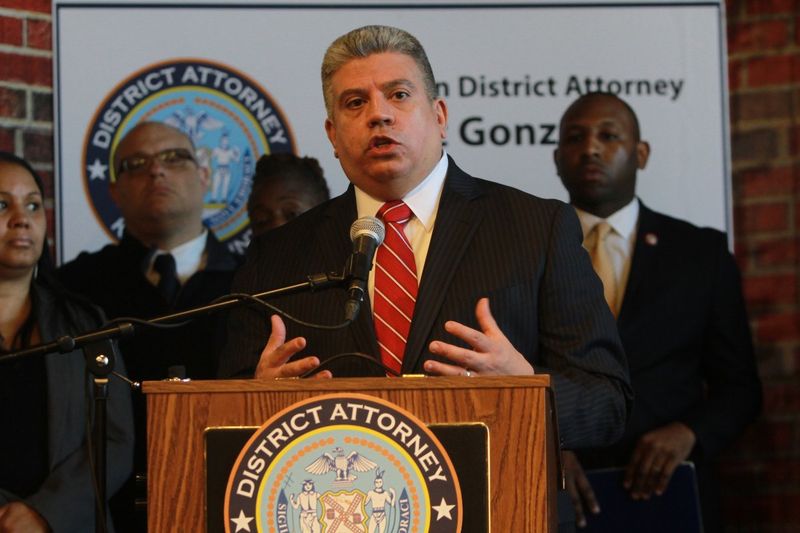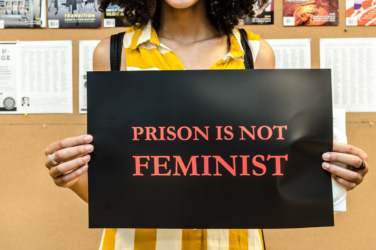I heard one of our regular participants at the syringe exchange got arrested,” says Alyssa Aguilera, co-executive director of VOCAL-NY.
When her client was charged with misdemeanor drug possession, he opted into Brooklyn’s Project CLEAR, a pre-arraignment diversion program that offers “low-level” possession defendants the chance to have their records sealed and charges dismissed—as long as they participate in a treatment program. CLEAR has positive features, but also serious flaws—including placing arrestees’ legal rights on a slippery slope.
CLEAR was launched by the Brooklyn District Attorney Eric Gonzalez (above) in February 2018 as a pilot at six New York Police Department precincts in south Brooklyn. By October, it was extended to the entire borough and hailed as a success.
“Instead of punishing those struggling with addiction, we must help put them on the path to recovery,” said New York City Council Speaker Corey Johnson in a press release. “With the establishment of CLEAR, the City will address drug addiction, like the opioid epidemic, as a public health crisis and offer treatment to those suffering from substance abuse, instead of criminal prosecution.”
How CLEAR Works
CLEAR’s intention is admirable: Reform the criminal justice system by embedding a therapeutic program within it, instead of continuing with criminal court adjudication and a potential misdemeanor conviction with up to one year in prison. CLEAR diverts participants to treatment prior to any appearance in court.
Participation seems effortless. Upon arrest, an officer at the participating Brooklyn NYPD precinct determines the individual’s eligibility, which requires a single charge for misdemeanor criminal possession of a controlled substance in the seventh degree (PL220.03), as well as the issuance of a Desk Appearance Ticket (an alternative to jailing the person).
The arrested person can accept or decline a treatment evaluation.
The precinct then contacts the DA’s office to receive the individual’s DAT return date–often within seven days of the arrest, instead of the usual 30. Next, upon contact with the DA’s office, the collaborating social services agency, EAC Network, dispatches a peer recovery coach to the precinct.
This non-law enforcement professional, trained in supporting people with drug use disorders, encourages the arrested person to receive a treatment evaluation within seven days, also offering naloxone kits and detoxification services. The arrested person can accept or decline the treatment evaluation.
If accepted, the EAC Network evaluation will take place within seven days, and the person is expected to “meaningfully engage” with the proposed treatment for 30 days. Upon the participant’s completion, DA Gonzalez, exercising his prosecutorial discretion, denies and seals the prosecution—allowing the arrested person to skip a court appearance.
If the arrested person declines the treatment evaluation, arraignment proceeds as usual.
Problematic Assumptions
In some ways, CLEAR is a step forward. “It is good that people have a chance to get their case dismissed,” Aguilera tells Filter. She also notes, “People can participate in CLEAR if they are repeating. A lot of diversion programs are limited to your first arrest.”
Her client’s outcome was positive, but it also illustrates the absurdity of any arrest-based system. After his arrest, he was referred back to VOCAL-NY’s syringe exchange program—a resource he already frequently used—begging the question of why he couldn’t have just been left to continue in that program without criminalization.
“It is disheartening that people have to go through these hoops in order to get charges dropped that probably should have never been there in the first place.”
CLEAR attempts to work within the criminal justice status quo to reform how drug charges are addressed. In doing so, it makes a couple of problematic assumptions: first, that defendants do not already have access to treatment; and second, that they need it.
Another CLEAR participant known to VOCAL does not even use drugs. “Somebody had pills on them that [did not belong to the arrested person]. The pills were just in the car,” Aguilera says.
New York State penal code states that a person can be charged with possession of a controlled substance just for being in a vehicle at the time of its discovery by law enforcement, irrespective of whether the person intended to use it or even knew of its presence.
“There are all these reasons why people have these arrests,” Aguilera says. “So it is disheartening that people have to go through these hoops in order to get charges dropped that probably should have never been there in the first place.”
“Frankly,” she adds, “there are definitely [CLEAR participants] who would not meet the criteria for what we screen for to even enroll people in our program.”
In recent years, programs like CLEAR have popped up around New York City and across the country, as policymakers recognize the failure of punitive responses to drug use.
“We have lost too many lives already to the heroin and opioid crisis to just continue with business as usual,” said Staten Island DA Michael E. McMahon at the February 2017 announcement of Project HOPE, a similarly lauded pre-arraignment program that inspired DA Gonzalez to adopt CLEAR in Brooklyn.
Other progressive prosecutors have followed suit. But often this just entails injecting treatment-oriented programs into a system that already criminalizes people who use drugs.
Negative Implications for Legal Rights
Treatment services, sealing a criminal record: Project CLEAR checks off some key points for drug policy reformers. But defense attorneys share concerns. New York defense attorney Don Murray, for example, notes that arrest in and of itself is “a serious event.” For him, CLEAR fails to properly reckon with the gravity of criminalization.
The project omits a key resource despite the high legal stakes involved for someone who has just been arrested. While Project CLEAR dispatches a peer recovery coach to the arresting precinct, a lawyer from the collaborating indigent defender service, the Legal Aid Society (LAS), is not automatically involved.
“Project CLEAR produces lawyerless transactions in the criminal justice system.”
According to the Brooklyn DA’s office, “The Legal Aid Society is available to assist both those who participate and those who opted not to participate in the program.”
When Filter asked by email how arrested individuals could access this assistance, the DA’s deputy director of communications sent the following response: “There is no LAS representative on-site, but LAS’s contact information is part of the CLEAR brochure and is given to arrested person at the time of arrest. LAS is also available at Criminal Court for consultations before any cases are docketed.”
Despite CLEAR’s intent to offer an alternative to criminal adjudication, the program therefore makes access to independent legal counsel—which would typically occur at an arraignment in a non-CLEAR arrest—less readily available to the arrested person than treatment.
This has many negative implications.
As Murray puts it, Project CLEAR produces “lawyerless transactions in the criminal justice system.” An uncounseled defendant is susceptible to making incriminating statements, he notes, perhaps confessing to a crime that was not included in the arrest charges.
“Defense attorneys are the only professionals qualified to offer legal advice that is in the defendants’ best interest,” adds Lisa Schreibersdorf, executive director of Brooklyn Defender Services. “Police, social service representatives and district attorneys cannot replace defense attorneys.”
For example, most CLEAR participants are unaware that a sealed record can still be reviewed due to a legal loophole. Although the relevant arrest record is sealed from public viewing as a way to prevent possible employment and housing discrimination, “qualified agencies [under Executive Law § 835(9)] and federal and state law enforcement agencies, when acting within the scope of their law enforcement duties” still retain the right to access the defendant’s record.
The potential negative impact of an arrest on a person’s ability to access vital resources is mitigated by Project CLEAR’s record-sealing, yet the individual remains criminalized in the eyes of many institutions. According to the New York State Defenders Association, these include “courts in the unified court system,” “probation departments,” “sheriffs’ offices,” “district attorneys’ offices,” “the department of correction of any municipality,” “the insurance frauds bureau of the state department of insurance,” “the office of professional medical conduct of the state department of health” “the office of Medicaid inspector general,” among a long laundry list of state bodies.
Murray and Schreibersdorf suspect that DA Gonzalez saw Project CLEAR as a win-win deal.
The constitutionality of “the admissibility of the evidence” in the case, Murray notes, is also easily overlooked by—or out of the frame of reference for—uncounseled defendants who could be “tempted to settle it all because the way the government describes” Project CLEAR. There could also be “substantial search issues” or “collateral issues” that could impact immigration or employment.
“How did this change improve the situation of the client?” asks Murray.
He and Schreibersdorf share a common answer: It doesn’t, really.
Murray and Schreibersdorf suspect that DA Gonzalez saw Project CLEAR as a win-win deal: Offer treatment to those arrested on drug charges, while also easing the bureaucratic load of court proceedings.
“There are fewer DATs in court. No pesky lawyers filing motions to suppress evidence or worse yet, pushing cases to trial because maybe the government’s case stinks,” says Murray. Instead, he thinks CLEAR “improved the situation of the DA’s office because there are fewer cases to prosecute in court,” which in turn would imply “that it might save the court system some money.”
I’m able to confirm this. Gonzalez told me in mid-September at a DA-sponsored event that Project CLEAR saves courts, jails, and public prosecutors and defenders money.
“Project CLEAR has already helped scores of individuals,” claimed DA Gonzalez in a press release. But the “scores of individuals” who successfully had their prosecutions denied and cases sealed totalled 71 people out of 153 eligible defendants—a relatively small number among the 2,187 individuals arrested in the first and second quarters of 2018 on charges eligible for Project CLEAR.
Do the budget savings from denying the arraignment of 71 people justify impeding their access to unbiased legal advice? Of course not. As Schreibersdorf says, “Access to a defense attorney is a constitutional right.”
What Needs to Change
Murray believes that defendants should be offered participation in Project CLEAR at arraignment. Schreibersdorf, on the other hand, takes no issue with pre-arraignment diversion. For her, CLEAR could still be offered at the police precinct before court documents are filed—but only if a defense attorney advises the eligible defendant about their options.
“The lawyer is able to explain to the defendant what happens if they do the program and what happens if they don’t do the program,” she says, noting that this is essential for a defendant to understand their options and the potential consequences.
And Schreibersdorf points to a precedent where defense attorneys were the pivot point for alternative adjudication.
Launched in 2015, Project Reset is a youth diversion program active in Manhattan and Brooklyn that helps 16- and 17-year-olds, and now adults, to “avoid court and a criminal record for first-time, low-level offenses.” Although Project Reset does not solely apply to drug charges, it does, in contrast to CLEAR, use a defense attorney to communicate a defendant’s programmatic options.
Schreibersdorf played a founding role in Project Reset, and has seen how it succeeds in ensuring that defendants receive legal advice. She believes that CLEAR is a symptom of a broader issue: Self-identified progressive district attorneys, like DA Gonzalez, think their scaled-back prosecutions can replace the counsel of public defenders.
Less aggressive criminal prosecution does not negate the fact of prosecution.
Just as simply injecting therapeutic programs into a criminalizing framework is inadequate, less aggressive criminal prosecution does not negate the fact of prosecution: Someone has been criminalized.
Project CLEAR presents nuanced issues. The program intends to support people accused of a drug possession in a way not previously offered, and can produce positive outcomes. Despite that, it also makes defendants more vulnerable to the fluctuating political will of the criminal justice system.
People who use drugs should not have to depend on that system to obtain treatment options, nor count on prosecutors to decriminalize them.
Photograph: Jesse Ward/for New York Daily News





Show Comments